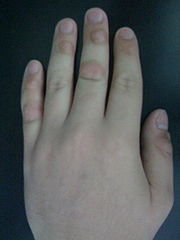
Body-focused repetitive behavior
Encyclopedia
Body-Focused Repetitive Behavior (BFRB) is an umbrella name for impulse control
behaviors involving compulsively
damaging one's physical appearance or causing physical injury.
The main BFRB disorders are:
BFRB disorders can also include Dermatophagia
(compulsive skin biting), biting the insides of the cheeks, lip picking, blemish squeezing, and Rhinotillexomania (compulsive nose picking). BFRB disorders are not generally considered obsessive-compulsive disorder
s.
 The cause of BFRBs is unknown. Emotional variables may have a differential impact on the expression of BFRBs. Researchers are investigating a possible genetic component.
The cause of BFRBs is unknown. Emotional variables may have a differential impact on the expression of BFRBs. Researchers are investigating a possible genetic component.
.
Impulse control disorder
Impulse control disorder is a set of psychiatric disorders including intermittent explosive disorder, kleptomania, pathological gambling, pyromania , and three body-focused repetitive or compulsive behaviors of trichotillomania , onychophagia and dermatillomania...
behaviors involving compulsively
Compulsive behavior
Compulsive behavior is behavior which a person does compulsively—in other words, not because they want to behave that way, but because they feel they have to do so....
damaging one's physical appearance or causing physical injury.
The main BFRB disorders are:
- TrichotillomaniaTrichotillomaniaTrichotillomania, which is classified as an impulse control disorder by DSM-IV, is the compulsive urge to pull out one's own hair leading to noticeable hair loss, distress, and social or functional impairment. It is often chronic and difficult to treat....
, compulsive hair pulling - Onychophagia, compulsive nail biting
- DermatillomaniaDermatillomaniaDermatillomania is an impulse control disorder characterized by the repeated urge to pick at one's own skin, often to the extent that damage is caused...
, compulsive skin picking
BFRB disorders can also include Dermatophagia
Dermatophagia
Dermatophagia is a form of obsessive-compulsive disorder wherein a sufferer compulsively bites their own skin. Sufferers typically bite the skin around the nails, leading to bleeding and discoloration over time....
(compulsive skin biting), biting the insides of the cheeks, lip picking, blemish squeezing, and Rhinotillexomania (compulsive nose picking). BFRB disorders are not generally considered obsessive-compulsive disorder
Obsessive-compulsive disorder
Obsessive–compulsive disorder is an anxiety disorder characterized by intrusive thoughts that produce uneasiness, apprehension, fear, or worry, by repetitive behaviors aimed at reducing the associated anxiety, or by a combination of such obsessions and compulsions...
s.
Causes

Prevalence
BFRBs are among the most poorly understood, misdiagnosed, and undertreated groups of disorders. BFRBs may affect at least 1 out of 20 people. Trichotillomania alone is believed to affect 6 million people in the United States.Treatment
Treatment can include behavior modification therapy, medication, and family therapyFamily therapy
Family therapy, also referred to as couple and family therapy, family systems therapy, and family counseling, is a branch of psychotherapy that works with families and couples in intimate relationships to nurture change and development. It tends to view change in terms of the systems of...
.
See also
- Stereotypic movement disorderStereotypic movement disorderStereotypic movement disorder is a disorder of childhood involving repetitive, nonfunctional motor behavior , that markedly interferes with normal activities or results in bodily injury, and persists for four weeks or longer. The behavior must not be due to the direct effects of a substance or...
- Rhythmic Movement DisorderRhythmic Movement DisorderRhythmic Movement Disorder is a neurological disorder characterized by involuntary, repetitive movements of large muscles groups immediately before and during sleep often involving the head and neck. It was independently described first in 1905 by Zappert as jactatio capitis nocturna and by...
- Body dysmorphic disorderBody dysmorphic disorderBody Dysmorphic Disorder is a type of mental illness, a somatoform disorder, wherein the affected person is exclusively concerned with body image, manifested as excessive concern about and preoccupation with a perceived defect of his or her physical features...

